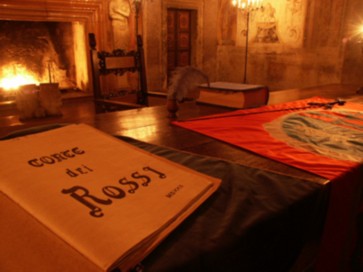
History

On 4th September 1499 Galasso da Correggio, trumpeter of the general lieutenant of the King of France Louis the Twelfth delivers all the keys of the lands and the castle of San Secondo to Troilo Rosso, who receives, in the same day, the oath of the place’s men.
On 15th August 1502 the King of France himself confirms the investiture of the "castellum et oppidum Sancti Secundi" to Troilo Rosso and raises the County to the rank of Marquisate.
On 28th July 1503 Bianca Riario, firstborn daughter of the virago Caterina Sforza and half-sister of the illustrious leader Giovanni de’ Medici called of the Black Bands, arrives in San Secondo as wife of Troilo, welcome with many honours.
During this marriage many children are born between 1504 and 1519. Pier Maria, feudatory from 1521 to 1547; Giovan Girolamo, Bishop of Pavia from 1530 to 1564 and governor of Rome from 1551 to 1555; Giulio Cesare, founder of the Rossi Family of Naples, Counts of Cajazzo; Bertrando, dead prematurely in 1527 at Valmontone; Ettore, ecclesiastic; Camilla, Giovanni of the Black Bands’ lover in her youth and then Girolamo Pallavicino’s wife; Angela Paola, Alessandro Vitelli’s wife of Cittą di Castello; Costanza, wife of the Florentine patrician Girolamo degli Albizi.
In 1521 Pier Maria becomes count of San Secondo.
The following year he has to defend the lands laid snares by the famished parents Bernardo, Bishop of Treviso, and Filippo Maria of Corniglio. Giovanni of the Black Bands succours him, takes all the lands and gives them back to the Rossi.
On 13th February 1523 the matrimonial contract between Pier Maria and Camilla, daughter of Giovanni Gonzaga, brother of the Marquis of Mantua Francesco, is drawn up.
Camilla’s dowry amounts to 6.000 ducats, and it’s payed in money, jewellery, clothes and furniture.
In 1542 Pier Maria is appointed by the King of France Francis the First, "general of Italians" and "chevalier of St. Michael’s order".
The court of San Secondo is open, during the XVIth century to the collaboration and patronage of artists and famous literary men, from Pietro Bembo to Francesco Mazzola called the Parmigianino, from Benvenuto Cellini to the great Pietro Aretino, "Scourge of Princes".
00